Left channel: Copper electrode on iron-ore bearing stone / Right rhanel: Aluminum electrode on quartz
If the mineral quartz is considered earth's preeminent microphone (see Earth Currents section), then mountain ranges themselves produce their own recordings - internally. Quartz literally signals agitations - such as earthquakes and rockslides - into its immediate surrounding inducing currents in its wake. The constant ebb and flow of geo-physical forces enact dynamic shifts in piezoelectric potentials within the rock, in what could be considered a form of inorganic sensation -- an expansive sense 'signaled' to the extent that it emits a myriad of electrical potentials, that never get cognized, at least not in the sentient sense. An electrical sensation of sorts strung between physical properties of the rocks and distributed undulations in the earth.
The brownish-orange patina on the quartz also attests to a curious terrestrial circuit where the vast majority of iron in earths crust is bound in silicate. In other words a terrestrial condition where microphones (quartz) are already found embedded in (iron) circuitry. An audiophile variant of such geological audio would be the rarer yet also common mineral bind of gold to quartz.
Possibly the most striking feature of the recordings conducted on August 8th is the clarity through which audio-frequency telluric currents manifest in the rocks. At an altitude of 3100 meters, and in the absence of power mains, the incessant clicking of sferics from distant lighting storms comes through in astonishing detail. More interestingly the audible qualities slightly differ depending on the minerals through which the sferics travel and the orientation of the telluric dipole in the rocks. The accompanying sample conveys a synchronous recording through two telluric dipole electrodes -- one channel through iron-bearing and the other through quartz-bearing stone. It also contains a curious interloper: a faint melody momentarily drifting in and out of audibility. This enigmatic piano phrase -- literally imbedded in stone -- apparently strayed from its radio signal path, drawn in by the seductive conductivity of the Venediger rock. Other signals were noticeably absent like the larger-scale geological movements impressed by the receding glacier and (still) rising tectonic plates. Apparently to hear phrases of that magnitude in the rocks we must further tune our geological ears.
On August 5th, 2018, an initial attempt was made to record a mountain from the vantage of its internal geoelectrics. Swaths of exposed white quartz above a glacier give this ridge its name 'Kristallwand' (crystal wall), while chunks of brownish-orange stones attest to the ore-rich components of the rock. The latter aspect of the Groß Venediger range (Austria) has attracted high-altitude mining in the region extending back to antiquity. Early mining in the region reached its peak in the 1600's -- around the time Georgius Agricola published his treatise on mining De re metallica libri xii -- when metals were primarily employed in the manufacture of implements such as axes and armor. Only later did such metals assume their role as prime electrical conductors -- first in lightning rods atop civic structures and finally in the miniature crisscrossing pathways on integrated circuit boards. Arguably these are not merely changes in mineral application but more fundamental shifts in mineral ontology altered by virtue of these other terrestrial circuits that have been set in motion.
The brownish-orange patina on the quartz also attests to a curious terrestrial circuit where the vast majority of iron in earths crust is bound in silicate. In other words a terrestrial condition where microphones (quartz) are already found embedded in (iron) circuitry. An audiophile variant of such geological audio would be the rarer yet also common mineral bind of gold to quartz.



